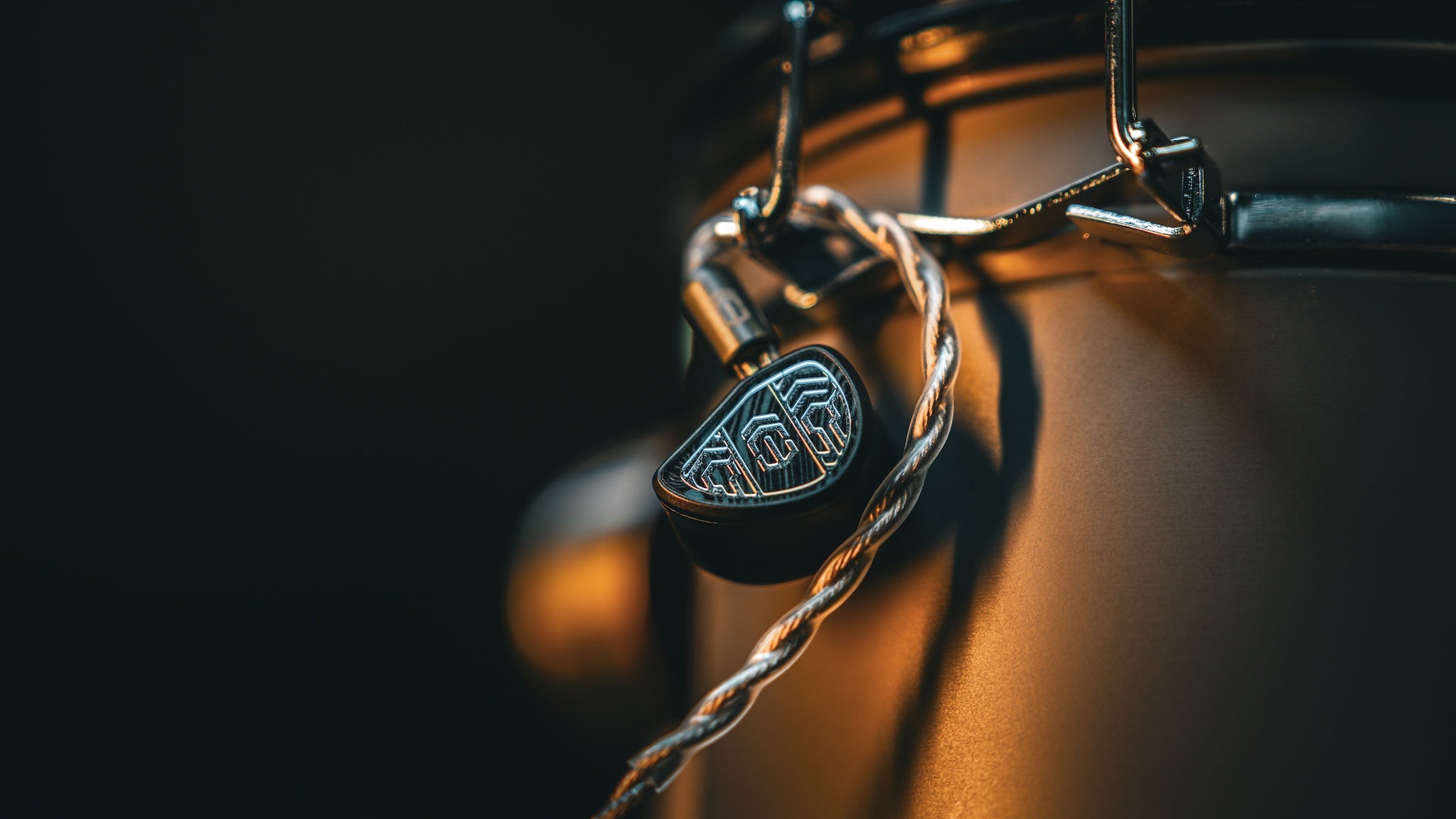If it wasn’t for CanJam Singapore 2024, this article would’ve never happened. To set the scene, I happened to enter the show early, and saw someone manning a booth by their lonesome. That worker was Ice Tung, lead acoustic tuning engineer for his company, Ice Lab. The two chairs at the booth were both available, so I sat down to check out the two IEMs presented on the table, both under the same name: “Prismatica.” You may have caught my impressions on Prismatica Gold, which was an extremely limited run of Prismatica that features a gold colorway, and of course a gold cable to round off the entire aesthetic. But now, having had the Prismatica here in the office for around a month or so, it's time to go into a bit more detail on what makes this $899 set so special to my ears.
Build and Design
Prismatica is one of the most complete packages under $1000 that we offer here at Bloom. With its all metal shell, Prismatica both looks and feels extravagant in its design, and the overall design of the logo and visual elements on the shell themselves look attractive without drawing too much attention. The fit is incredibly snug, and the all metal shell is surprisingly lightweight, meaning these can be kept in your ear for hours on end with no fatigue. The included silver-plated copper cable terminated in 4.4mm has little to no memory to it, and is one of my favorite stock cables included in an IEM. Both the Y split and terminating end complete the overall look with the substantial silver housing, encapsulating the incredibly premium feel of this cable.
The rest of the accessories included carry over Ice Labs’ intention of delivering an unboxing experience that's incredibly well designed and put together. The aluminum uses the mostly industrial elements that is shown throughout the entirety of Prismatics design focus, and it feels substantial and weighty in the hand. The screws, whether necessary or just for looks, bolster the weight and overall feel of the case as well. The included brown leather cable clip adds a splash of color to the package, as well as the Symbio-like eartips that are the stock tips of choice here. You get your choice of straight silicone, a silicone foam hybrid, or the regular foam tips as well. While I opted to stick with my SpinFit Omni’s for almost all of my listening sessions, I’m sure some listeners out there will be pleased to use these tips with Prismatica and add them to their collection.
In total, Prismatica’s package is packed with some goodies, and while some IEMs may have the upper hand in something like a modular cable, it's hard to think of an IEM in this price bracket that offers a total offering better than Prismatica. But does Prismatica couple a great package with great sound?
Sound
Featuring an all balanced armature sound that has a Knowles subwoofer for the bass, 2 Sonion composite UHF drivers for the mids, and 2 full-range monomers for the highs, Prismatica’s driver implementation sets itself up for a mostly tame and more laid back listen that focuses on detail retrieval and tonality. Well, not necessarily.
Starting in the bass, which I find to be Prismatica’s key highlight of the sound signature, the Knowles subwoofer is putting in overtime to surpass the sheer amount of low end you’d expect from a dynamic driver implementation. However, the balanced armature bass response takes things a bit further by adding the same amount of rumble and hit you’d expect with the dynamic driver, but adds that resolving nature that only a balanced armature can truly produce. Having spoken with Ice in Singapore, he told me that he wanted to tune something that he personally wanted to listen to. After hearing his preferred genre was EDM, a lot of Prismatica’s sound signature made sense. House music in particular was not only my preferred genre of choice with Prismatica, but I frequently sought after new tracks and artists to continually uncover Prismatica’s magic hiding behind every corner. Jack Marlow’s “Tastes Like the 90s” became a highly frequented album, with “Tell Me Where Your Heart Is” being a must play each and every listen to hear that hard thumping bass of the Prismatica. Not only do you get a solid amount of rumble in the subbass, but more prominently, you get an incredible amount of hit to the bass that allows you to feel the power behind every kickdrum and 808, making a multitude of different rap tracks and EDM incredibly lively that’s bolstered behind a bass that had me continually coming back for more.
The midrange on the Prismatica recesses things slightly in the lower mids to make room for a decent amount of elevation in the mid bass, but with a slight bump in upper mids to bring vocals a little bit more forward. You also have a midrange that's incredibly engaging, while still keeping the overall coherency of the sound signature intact. Instruments have a mostly natural timbre to them, and electric guitars in particular have a certain energy to them that keeps Prismatica a very up beat and high octane listen. Rock in general brings out the best of what Prismatica has to offer in the tuning of its mids, and Holywatr’s “I Won’t Forget” track off of his record Psalms boasts an incredibly weighty and thick electric guitar that pairs incredibly well with the emotional vocals that are really brought to life by Prismatica’s sound signature. And for a more relaxed listen, something like the Cayin N3 Ultra smooths out the overall dynamics of the mix, letting the timbre of the mids - and the whole spectrum of Prismaticas sonic presentation for that matter - really come through. A track like “Ti-de” from the ensemble Kokoroko properly portrays the complete package. From the rich and heavy bass notes, to the excellent brass portrayal, all backed by the aforementioned electric guitar play is just simply brilliant across the board.
Prismatica’s treble isn’t the most resolving or particularly sharp, but it does continually convey the energy that is carried through the entirety of its sound signature by adding enough air and brilliance up top to complete the sound signature. I can’t characterize Prismatica as being smooth up top, but if you’re looking for the most you can get out of an IEM’s treble within this price range, you can probably consider some other options. However, for those looking for something upbeat without treble fatigue, Prismatica offers a sound that's incredibly digestible, yet still has a good bit of detail retrieval up top. While I admittedly much preferred warmer sources with the Prismatica, I did reach for the D16 Taipan - something I categorize as mostly reference - to try and get a good grasp on what Prismatica can really offer in the top end. I felt that on a track like “Love You To” from The Beatles’ Revolver album, Prismatica always got you to that point of the necessary amount of extension and air without being overpowering or even under delivering.
The contrast in Prismatica’s sound signature is incredibly unique to me, and at times, I don’t quite understand how it can sound as wide as it does at times. There's a sense of spaciousness that is incredibly captivating and can best be demonstrated on Black Sabbath’s “Planet Caravan,” with bongos dispersing throughout the whole image, the faded and distant guitar playing to your right, and the vocals shifting slightly to the left leaves you with this clear and well deciphered picture of the mix that is discerned and well separated from each other. While I won’t say that Prismatica is groundbreaking in its spatial imaging, it holds its own in this regard, and never feels overly congested or cramped, which is a huge win considering the amount of forwardness you get with the midbass.
Comparison
While we were able to cover a good portion of Prismatica’s sound signature, it was only a matter of time until we subjected it to comparison against another titan within this price range - enter Monarch MKIII. At $999, Monarch MKIII has become a surefire pick for buyers in the sub $1000 price range, and it feels like the competition only grows stiffer and stiffer by the minute. For all comparative listening, I kept the source strictly to my DX180, my current best point of reference within a source.
I was hesitant to pit these two up against each other due to the differences in driver configuration. Monarch MKIII stacks up against Prismatica’s all balanced armature implementation by going with 2 dynamic drivers, 6 balanced armatures, and 2 electrostatics. I even thought of going outside of this price bracket and going with the V16 Divinity, ThieAudio’s all balanced armature IEM. But alas, here we are, and the results weren’t what I initially expected.
To quickly go over the package of both IEMs, ThieAudio wins with the inclusion of the modular cable. But aside from that, Ice Labs takes over from there. The cable as a whole on Prismatica feels more luxurious, and completes the overall look of Prismatica more than Monarch MKIII’s. Monarch MKII’s cable was one that I wish was revisited to separate Monarch MKIII from others within the ThieAudio lineup, but instead the standard cable included with almost every new ThieAudio IEM has somewhat over-welcomed its stay. I also find the aluminum case to be a bit more notable than the standard zip-up case included with MKIII. As a whole, both packages I believe will satisfy buyers within this price range, but I side with Prismatica as delivering a more complete experience.
For the sound signature, what seems to be most apparent to me is Prismatica’s in your face nature. While Monarch MKIII looks to captivate you with its incredible all rounder ability, Prismatica takes risks in its overall aggression and punch down low. It's unapologetically weighty and hard hitting, with note weight that's incredibly full and rich. Sub bass growls and bounces in your ear, while the Monarch MKIII will deliver a sub bass that extends and is more true in its delivery. And while Prismatica can exaggerate things, it still does it in a tasteful way that doesn’t feel over the top ridiculous - especially considering that it can tone things back on more relaxed tracks when need be. However, to those looking for something more tame and more focused on the technical details, yet still providing something up beat and engaging, that's where Monarch MKIII shows its true colors. Again, as a more complete all rounder, Monarch MKIII will most likely appease listeners more than what Prismatica has to offer. Especially when factoring in its overall treble performance and extension, which can offer slightly more zest and brilliance in the treble. But as a true specialist of high energy and dazzling low end performance, Prismatica provides a sound signature that leaves little to desire in terms of rumble and punch. Although Monarch MKIII, to my ears, feels like it still maintains the crown it's worn for so long in a pound for pound bout, Prismatica was the one I returned to more often for its assertive and aggressive sound signature that I simply couldn’t get enough of.
Final Thoughts
Ice Tung sought to create something that would satisfy his own audio cravings and preferences. In any creative outlet, fabricating something that resonates with you often yields the best results, and that's exactly what Prismatica embodies to me. In a hobby that relies heavily on the populous and their tonal preferences, I applaud Ice for creating something that can go against the grain at times. In doing so, Prismatica feels different from anything I’ve heard in quite some time, and it’s the IEM I continue to reach towards any chance I can.












